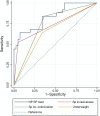Nasopharyngeal bacterial load as a marker for rapid and easy diagnosis of invasive pneumococcal disease in children from Mozambique
- PMID: 28910402
- PMCID: PMC5599037
- DOI: 10.1371/journal.pone.0184762
Nasopharyngeal bacterial load as a marker for rapid and easy diagnosis of invasive pneumococcal disease in children from Mozambique
Abstract
Background: Current diagnostic methods for detection of Streptococcus pneumoniae in children with suspected invasive pneumococcal disease have limitations of accuracy, timeliness, and patient convenience. This study aimed to determine the performance of pneumococcal load quantified with a real-time polymerase-chain reaction in nasopharyngeal samples to diagnose invasive pneumococcal disease in children.
Methods: Matched case-control study of patients <5 years of age with invasive pneumococcal disease admitted to the Manhiça District Hospital (Mozambique) and asymptomatic controls recruited in different periods between 2006 and 2014. Cases were confirmed by a positive bacterial culture for S. pneumoniae in blood or cerebrospinal fluid. Nasopharyngeal aspirates were collected from cases and controls and pneumococcal density was quantified by lytA real-time polymerase-chain reaction.
Results: Thirty cases (median age 12.8 months) and sixty controls (median age 11.7 months) were enrolled and 70% of them were male. Nasopharyngeal pneumococcal carriage was high in both groups: 28/30 (93.3%) for cases vs. 53/60 (88.3%) for controls (p = 0.71). Mean nasopharyngeal pneumococcal load was identified as a marker for invasive pneumococcal disease (7.0 log10 copies/mL in cases vs. 5.8 log10 copies/mL in controls, p<0.001) and showed good discriminatory power (AUC-ROC: 82.1%, 95% CI 72.5%-91.8%). A colonization density of 6.5 log10 copies/mL was determined as the optimal cut-off value to distinguish cases from controls (sensitivity 75.0%, specificity 73.6%).
Conclusion: Use of non-invasive nasopharyngeal aspirates coupled with rapid and accurate quantification of pneumococcal load by real-time polymerase chain reaction has the potential to become a useful surrogate marker for early diagnosis of invasive pneumococcal disease in children.
Conflict of interest statement
Figures
Similar articles
-
Evaluation of Pneumococcal Load in Blood by Polymerase Chain Reaction for the Diagnosis of Pneumococcal Pneumonia in Young Children in the PERCH Study.Clin Infect Dis. 2017 Jun 15;64(suppl_3):S357-S367. doi: 10.1093/cid/cix149. Clin Infect Dis. 2017. PMID: 28575374 Free PMC article.
-
Bacterial load of pneumococcal serotypes correlates with their prevalence and multiple serotypes is associated with acute respiratory infections among children less than 5 years of age.PLoS One. 2014 Oct 31;9(10):e110777. doi: 10.1371/journal.pone.0110777. eCollection 2014. PLoS One. 2014. PMID: 25360707 Free PMC article.
-
Pneumococcal bacterial load colonization as a marker of mixed infection in children with alveolar community-acquired pneumonia and respiratory syncytial virus or rhinovirus infection.Pediatr Infect Dis J. 2013 Nov;32(11):1199-204. doi: 10.1097/INF.0b013e31829ec274. Pediatr Infect Dis J. 2013. PMID: 23743541
-
Serotype distribution and antibiotic susceptibility of invasive and nasopharyngeal isolates of Streptococcus pneumoniae among children in rural Mozambique.Trop Med Int Health. 2006 Mar;11(3):358-66. doi: 10.1111/j.1365-3156.2006.01565.x. Trop Med Int Health. 2006. PMID: 16553916
-
PCR using blood for diagnosis of invasive pneumococcal disease: systematic review and meta-analysis.J Clin Microbiol. 2010 Feb;48(2):489-96. doi: 10.1128/JCM.01636-09. Epub 2009 Dec 9. J Clin Microbiol. 2010. PMID: 20007385 Free PMC article.
Cited by
-
Unraveling the seasonal epidemiology of pneumococcus.Proc Natl Acad Sci U S A. 2019 Jan 29;116(5):1802-1807. doi: 10.1073/pnas.1812388116. Epub 2019 Jan 14. Proc Natl Acad Sci U S A. 2019. PMID: 30642967 Free PMC article.
-
Pneumococcal colonization prevalence and density among Thai children with severe pneumonia and community controls.PLoS One. 2020 Apr 29;15(4):e0232151. doi: 10.1371/journal.pone.0232151. eCollection 2020. PLoS One. 2020. PMID: 32348330 Free PMC article.
-
Pneumonia in children admitted to the national referral hospital in Bhutan: A prospective cohort study.Int J Infect Dis. 2020 Jun;95:74-83. doi: 10.1016/j.ijid.2020.04.017. Epub 2020 Apr 10. Int J Infect Dis. 2020. PMID: 32283281 Free PMC article.
-
Streptococcus pneumoniae Serotypes Carried by Young Children and Their Association With Acute Otitis Media During the Period 2016-2019.Front Pediatr. 2021 Jul 5;9:664083. doi: 10.3389/fped.2021.664083. eCollection 2021. Front Pediatr. 2021. PMID: 34291017 Free PMC article.
-
Pneumococcal colonization and coinfecting respiratory viruses in children under 5 years in Addis Ababa, Ethiopia: a prospective case-control study.Sci Rep. 2024 Feb 20;14(1):4174. doi: 10.1038/s41598-024-54256-w. Sci Rep. 2024. PMID: 38378681 Free PMC article.
References
-
- Liu L, Oza S, Hogan D, Perin J, Rudan I, Lawn JE, et al. Global, regional, and national causes of child mortality in 2000–2013 with projections to inform post-2015 priorities: an updated systematic analysis. Lancet. 2015; 385(9966):430–40. doi: 10.1016/S0140-6736(14)61698-6 . - DOI - PubMed
-
- Mackenzie GA, Leach AJ, Carapetis JR, Fisher J, Morris PS. Epidemiology of nasopharyngeal carriage of respiratory bacterial pathogens in children and adults: cross-sectional surveys in a population with high rates of pneumococcal disease. BMC Infect. Dis. 2010;10:304 doi: 10.1186/1471-2334-10-304 . - DOI - PMC - PubMed
-
- WHO Publication. Pneumococcal vaccines WHO position paper– 2012 –recommendations. Vaccine 2012;30(32):4717–8. doi: 10.1016/j.vaccine.2012.04.093 . - DOI - PubMed
-
- Bogaert D, De Groot R, Hermans PWM. Streptococcus pneumoniae colonisation: The key to pneumococcal disease. Lancet Infect. Dis. 2004; 4:144–154. doi: 10.1016/S1473-3099(04)00938-7 . - DOI - PubMed
-
- Ciruela P, Broner S, Izquierdo C, Hernández S, Muñoz-Almagro C, Pallarés R, et al. Invasive pneumococcal disease rates linked to meteorological factors and respiratory virus circulation (Catalonia, 2006–2012). BMC Public Health 2016; 16:400 doi: 10.1186/s12889-016-3061-6 . - DOI - PMC - PubMed
MeSH terms
Substances
LinkOut - more resources
Full Text Sources
Other Literature Sources
Medical


